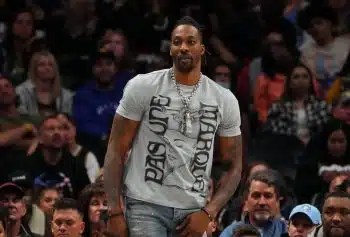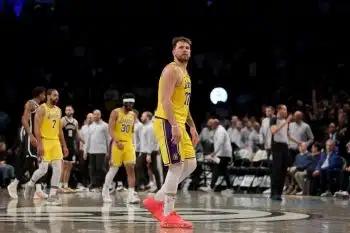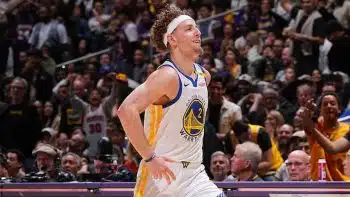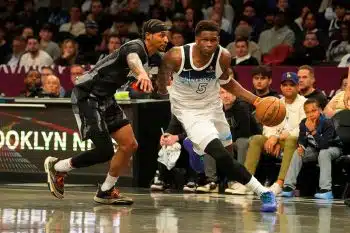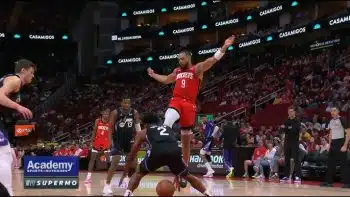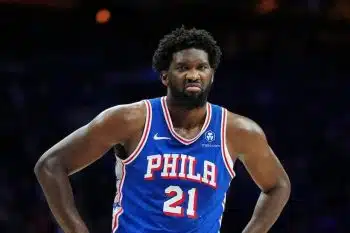NBA
2014-2015 Utah Jazz Season Preview
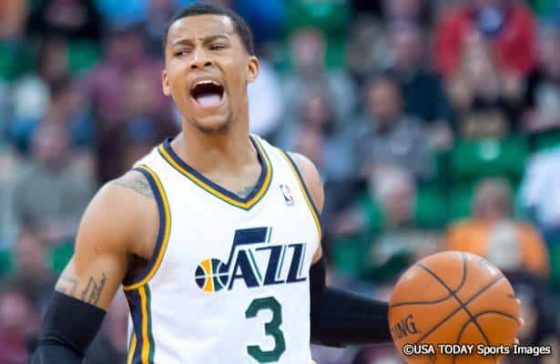
The Utah Jazz replaced Ty Corbin with Quin Snyder, kept Gordon Hayward and added some veteran experience during a relatively quiet offseason. Two years removed from their last playoff appearance, they’re banking heavily on internal development to help them move up the ranks in the ever-improving Western Conference.
Basketball Insiders takes a look at the 2014-2015 Utah Jazz.
Five Guys Think
It feels like the Jazz have been a “promising young” team for the last half decade, and with so much youth on the team again this season it doesn’t seem likely that they’ll be in the mix for a playoff spot this year, either. Gordon Hayward is the first of the youngsters to get his massive extension, so he’ll be looked upon to be the leader of the team this year, but with Derrick Favors, Trey Burke and now rookie Dante Exum all in the fold, there’s plenty to be excited about in Salt Lake City. Of course, we’ve been saying that for a few years now. Sooner or later, they’re going to have to stop amassing young talent and start winning some games. This season should be a bridge to better things.
4th Place – Northwest Division
-Joel Brigham
Over the offseason, I stated that the Jazz have assembled one of the best young cores in the NBA with talented players like Trey Burke, Dante Exum, Derrick Favors, Gordon Hayward, Enes Kanter, Alec Burks, Rudy Gobert and Rodney Hood. I stand by that statement and believe that the future is very bright for the Jazz. It’ll be interesting to see how new head coach Quin Snyder uses Exum and Burke in the backcourt, and how all of the pieces will come together. But there’s no doubt that Utah has the talent in place to be a very good team in several years. In the meantime, they just need to keep developing their young players and giving them experience. They probably won’t win many games in the 2014-15 season, but they should show some improvement and take a step in the right direction. Then, they’ll add yet another lottery talent in next year’s draft and pretty soon we should be talking about Utah as a team that can make noise in the Western Conference.
5th Place – Northwest Division
– Alex Kennedy
The 2014-15 campaign may very well represent another year in the league basement for the Utah Jazz, but the franchise has plenty of young talent up and down the roster. Now we play the waiting game and see how long it will take the talented group of young players to develop the chemistry needed to win at the professional level. However, while the youth develops at their own place, two players who need to take huge steps this season are Derrick Favors and Gordon Hayward. Both guys are getting paid like All-Stars and are oozing with upside. Now it’s time for them to take their games to another level. If they can, the Jazz may be able to add 10 more wins to last season’s victory total (25).
5th Place – Northwest Division
– Lang Greene
Over the next four years, the Utah Jazz have committed more than $100 million to the duo of Gordon Hayward and Derrick Favors. Although Hayward appears to be a star on the rise, it is difficult imagining these two helping the Jazz even come close to escaping the cellar in the Western Conference. Steve Novak and Trevor Booker were both low cost acquisitions, but the biggest question for the Jazz heading into the season will be whether Dante Exum is ready for this level of basketball and how he will coexist with Trey Burke. The Jazz opting to select Exum with the fifth overall pick in last June’s draft was questionable considering Exum’s stated desire to play point guard in the NBA, despite having shooting guard height. It will be another long season in Salt Lake City, marked mostly by new head coach Quin Snyder trying to make sense of the pieces he has been given. Unfortunately, another trip to the lottery awaits.
4th place – Northwest Division
– Moke Hamilton
The Utah Jazz are at the most difficult part of the rebuilding process. They’ve yet to land a true No. 1 option in the draft, but have already handed out a significant amount of cash to keep their top players coming off of their rookie contracts in Derrick Favors and Gordon Hayward. Quin Snyder coming in and replacing Ty Corbin will provide a fresh, new presence at the head coaching position, but he’s not going to have much more to work with than Corbin did. This team’s ceiling still seems relatively the same, barring some serious internal development. There was a lot of hype surrounding their top draft pick Dante Exum prior to the draft, but an underwhelming showing at Summer League and the FIBA World Cup has brought expectations back down to reality. Overall the Jazz are worth watching and have potential, but the West remains brutally tough and they don’t look any better than last place in their division, once again.
5th place – Northwest Division
– Yannis Koutroupis
Top Of The List
Top Offensive Player: Once again the Utah Jazz will call upon swingman Gordon Hayward to shoulder the bulk of the scoring load as the most experienced member of the team. We are talking about a versatile guy who has upped his scoring average every year he’s been in the league and shows the type of budding talent that led the Charlotte Hornets to offer him a max contract this summer. Jazz general manager Dennis Lindsey and ownership felt confident enough in Hayward’s ability to continue his trend upwards to match that contract. With a lack of scoring on the team, Hayward’s shooting percentages last year by his own account were not where he wanted them to be as defenses were keen to hone in on stopping him in his new role as the primary offensive focal point. Coming into his own heading into his fifth NBA season, look for him to step up his shooting and lead the team on offense.
Top Defensive Player: When searching for a defensive anchor in the middle that will have opposing offensive players checking over their shoulders, look no further, Derrick Favors is your guy. A unique physical specimen with a 7’4 wingspan and a 9’2 standing reach, he was 19 years old when he entered the NBA (the youngest in the NBA at the time) after leaving school early from Georgia Tech. Four years later, he is beginning to scratch the surface of his potential as he’s started to match his tremendous physical tools and defensive instincts with an evolved understanding of the game. In his young career, he has already established himself as an imposing shot blocking force by averaging nearly two blocks per game. Don’t let his calm demeanor fool you and look for him to captain the defense next season with more experience under his belt.
Top Playmaker: This technically could be a three-headed monster between Trey Burke, Gordon Hayward and newcomer Dante Exum as they will all be asked to facilitate the offense for head coach Quin Snyder next season. However, the nod will go to Burke considering as an All-Rookie First Team player he led the team with 5.7 assists per game. Burke also proved to have a steady hand in minimizing his mistakes on the court and taking care of the rock, posting an excellent, rookie-low 1.9 turnovers per game. Compare that to last season’s Rookie of the Year Michael Carter-Williams, who committed 3.9 turnovers per game and you can see why Burke was known to be such an excellent floor general coming out of Michigan. No longer a rookie, look for him to further improve his playmaking skills with another year under his belt and more offensive weapons on the team. He has a lot to prove this year with another playmaking guard added to the roster in Exum, who has lofty expectations of his own.
Top Clutch Player: The departure of dependable veteran big men Al Jefferson and Paul Millsap left the Jazz searching for someone who would be able to step up to get buckets when they need it the most. While swingman Gordon Hayward did have his moments last year, it was Trey Burke in the end who showed the most poise in the clutch for the team. While to some he may have had a disappointing rookie season, with the game on the line it was Burke that led the team in points scored (2.4), free throw shooting (93.3 percent), three-point shooting (57.1 percent) and shooting from the field overall (51.9 percent). The Jazz are hopeful the game-winning three pointer he hit over the outstretched arms of the Orlando Magic’s Victor Oladipo last March is a sign of future things to come.
The Unheralded Player: While many of the other players mentioned previously are known to be part of the future core for the Jazz, there are two players with the potential to be included in the group but still have some questions marks. We are talking about Alec Burks and Enes Kanter. Both of these players have shown flashes of brilliance in their time with the Jazz and will be coming into contract seasons eager to prove they are worthy of getting a nice payday. My money is on Burks breaking out this season. He doubled his scoring average last year from seven points to 14 in his third year in the league and looked to be playing more under control than ever before. He also noticeably improved his passing, nearly doubling his average to 2.7 assists per game from the previous year with the increased playing time. Burks also has a knack for getting to the line and being able to create his shot, which are unique skills that the team lacks. Look for him to lead the second unit and continue his trajectory upwards for this young Jazz team.
Best New Addition: There’s no question the best new addition to the Jazz (and the player who will be receiving the most buzz coming into the season) will be Dante Exum. The man dubbed the biggest mystery heading in this June’s NBA Draft brings a lot of excitement, optimism and curiosity about how he will fit not only in the NBA but also with this Jazz team. There’s a lot to like about the 19-year-old Australian wunderkind Exum. He has excellent size to be able to play either guard spot, standing at 6’6 in shoes. He dazzled NBA scouts and GMs at the NBA Draft Combine by beating every other drafted point guard with blazing fast lane agility and sprint times. He will be one of the fastest players in the NBA from day one. If that isn’t enough to get you excited, he plays the game with a nice fluidity, has a tremendous first step and loves to get into the paint to be a playmaker for his teammates. While many of his detractors will say he hasn’t played against top competition playing for the Under 19 Australian team, his supporters will point to his excellent performances against many of his peers that went on to play collegiately in the same class at the Nike Hoop Summit. His shot is still a work in progress but he comes to the Jazz with a tremendous work ethic, has impressed with maturity beyond his years and will be given every opportunity to prove he was worthy of being a top pick in the draft.
– E.J. Ayala
Who We Like
Dennis Lindsey: Coming from a tremendous tree of successful coaches and executives from the San Antonio Spurs and Houston Rockets organizations, there’s a lot to like about Lindsey. The general manager’s calm methodical nature and eye for talent has already seen him transform this Jazz team into one of the most promising young cores in the league. After the Jerry Sloan era and the trade that sent Deron Williams packing to the Nets, many were left wondering where the organization would go from there. It has taken some time for the plan to take shape, but we are starting to see the vision Lindsey sold Jazz owner Greg Miller on when he was first hired back in August of 2012. In the short while at the helm, Lindsey has managed to collect assets in the form of draft picks and trade exemptions, and he has made shrewd trades with the long-term plan in mind. He has eliminated aging players, drafted reasonably well and kept the team under the salary cap, all the while only having one losing season, which was last year and by design. Flexibility is the name of the game in today’s NBA and with a small-market team in Utah, the margin for error is slim. Now with a coach of his own choosing in the fold in Quin Snyder that shares the same basketball philosophy, we will see yet another piece added to the puzzle as he continues to make his mark on the Jazz organization. While there is still plenty of work to be done for his vision to come to fruition, the future in Utah looks bright.
Quin Snyder: The Jazz named Snyder as their new head coach this summer. What he brings to the table is an incredible amount of leadership and coaching success at every level he’s been at. When he’s been part of an organization (as a head coach, assistant coach or otherwise), he has an outstanding record: 616-385. That’s good for about a 62 percent winning percentage. He’s just a winner. He’s also a former point guard and team captain for the Duke Blue Devils under head coach Mike Krzyzewski, and he knows what it takes to bring a team together. With two young promising talents in Trey Burke and Dante Exum in the fold, look for Snyder to help them reach their full potential as both players and leaders. Snyder is also more of the new breed of coaches that blend traditional basketball knowledge with the new wave of advanced analysis we see the league trending toward. Also, former players who have worked with him have raved about his attention to detail with player development. Former Jazz player DeMarre Carroll went on record to say that Snyder was the first coach to ever spend extra time helping him with his footwork, which paid dividends for his growth last season. This type of help can only be a good thing for one of the youngest teams in the league with plenty of room to grow.
Rodney Hood: While his top-five pick teammate Dante Exum may have had the most buzz leading up to the draft, it was swingman Rodney Hood who at times shined as the most impressive rookie during Vegas Summer League. Drafted 23rd overall in the 2014 NBA Draft, many draft experts considered the Jazz selection to be an absolute steal as he was projected to be picked much earlier. The sweet shooting southpaw definitely showed his three-point range, rounded out floor game and solid decision making skills this summer. Don’t be surprised to see the former Duke captain come out of the gate as the more NBA-ready player, even though Exum may have a much higher ceiling.
Rudy Gobert: Standing at an imposing 7’1 with a freakishly long 7’9 wingspan, an NBA Combine record at the time, Gobert possesses elite physical tools as a defender. Hailing from France as a rookie last season, Gobert looked every bit the raw center prospect. While at times we saw flashes of dominant defensive potential, other times he looked completely lost on defense and slow to react. What a difference a year makes, as he was very impressive this summer and was named to the Vegas Summer League Second Team, posting 11.8 points per game, 2.5 blocks per game and an unreal 73 percent from the field overall. The Frenchman, who continued to show intriguing flashes during the FIBA World Cup, appears to have improved his feel for the game, put some time in the gym and looks to be more confident coming into his second season with the Jazz.
– E.J. Ayala
Strengths
Youth, talent and flexibility are some things the Jazz can count on next season. That translating into wins is a whole other matter, considering the Jazz were one of the worst teams in the league last season. Look for new head coach Quin Snyder to maximize that young energy next season by playing with a quicker tempo and a heavy emphasis on ball movement. The Jazz have bigs that can run the floor in Derrick Favors, Enes Kanter and reserve high-flyer Jeremy Evans. They’ve addressed some shooting concerns with the addition of three-point specialist Steve Novak and drafting of Rodney Hood. They’ve also shored up the frontcourt bench with the additions of forward Trevor Booker, who brings toughness and the ability to score down low. The Jazz will be relying heavily on Gordon Hayward, Trey Burke and Derrick Favors to lead the team. Those key players will need to take the next step in order for the Jazz not to have a repeat of last season.
– E.J. Ayala
Weaknesses
There’s a reason why during summer league Coach Snyder made it a point to praise good defensive play first before anything that happened on the offensive end of the court. To say the Jazz last season were not a good defensive team would be an understatement. They were in the bottom half of the league with 102.2 opponent points allowed per game. While Favors and Gobert are both good rim protectors, it will take a total effort from a team standpoint to really turn things around next season. Shooting is another thing that plagued the Jazz last season as they were the seventh worst shooting team in the league overall with a 44 percent field goal percentage. The Jazz are hoping the new additions, continued growth of core players and additional emphasis on player development will help the team improve their shooting next season.
– E.J. Ayala
The Salary Cap
The Jazz chose to match the Charlotte Hornets’ offer to Gordon Hayward, inking the former restricted free agent for four years, $63 million. Utah also added Trevor Booker in free agency and traded for veteran shooter Steve Novak. While still under the salary cap, the Jazz have 18 players under contract, five with partial or non-guaranteed salaries. The Jazz can get to about $5.7 million under the cap, cutting players like Toure’ Murry ($250k of his $1 million is guaranteed), Kevin Murphy, Dee Bost, Jack Cooley and Brock Motum. The Jazz are still in a position to use their cap room to take on another team’s unwanted salary, in return for draft considerations. Utah still has their $2.7 million Room Exception, once they climb over the cap — but the issue is roster space, not spending power.
– Eric Pincus
Dunc’d On
For the first time since the 2011 departure of Deron Williams, there is reason for true long-term optimism in Utah. While the team has had draft assets and cap flexibility over the past few years, a return to contention was always theoretical without a player in the fold who realistically could become a star. With Dante Exum now in the fold, a Jazzman finally has that kind of upside, though he has a long way to go before realizing it.
In the brutal Western Conference, the Jazz do not have any realistic hopes of contending for the playoffs this year. But Jazz fans cannot be blamed for expecting significant improvement this year. The team did win 25 games last year with a young core, and had stretches of near-.500 ball during the heart of the season. Nearly every returning player projects to be better than last season.
But Utah was a bit lucky last year, posting the point-differential of a 22-win team. And while few may lament the departures of Richard Jefferson and Marvin Williams—both of whom were overstretched as starters a year ago—the fact remains that they provided valuable floor-spacing for Utah last year. The combination of Favors and Kanter was disastrous offensively last year in large part due to the lack of passing and spacing they provided. Exum also projects to play significant minutes, but the odds of him being a winning contributor this year are low due to his inexperience and developing jump shot.
Interested betting on the Utah team? – Don’t miss out on reading our guide about sports betting in Utah first!
On the other hand, Quin Snyder could provide an upgrade on both ends from a coaching perspective. Rudy Gobert has looked excellent in summer league and FIBA play, and if he can play reasonable minutes with Favors it would be possible that the Jazz significantly improve their 30th-ranked defense. Favors, Kanter, Alec Burks, Trey Burke, and Gordon Hayward could all take significant steps forward, especially on defense.
Best Case
31-51
The Jazz defense improves significantly as Gobert gets more minutes and Favors and Kanter learn the ropes. The latter two develop serviceable jump shots, allowing them both to play with Gobert, while Trevor Booker becomes the fourth member of a solid frontcourt rotation. Burke improves his ability to get to the rim, Burks and Hayward improve their shooting, and the Jazz offense improves slightly as a result.
Worst Case
21-61
Burke’s inability to finish and poor summer league portend little improvement. Synder, who would likely prefer a shooter at the four, proves unable to create an improved offense from limited-range bigs. Gobert proves so bad offensively the he falls out of the rotation, while Exum either a) is unplayable at backup point guard or b) is unplayable at backup point guard and gets development minutes anyway. Hayward and Burks show that they have essentially reached their ceilings. By March and April, the Jazz are playing only for lottery positioning.
– Nate Duncan
The Burning Question
Do the Jazz Have Enough Star Power?
The easy answer to the question is no, at least not right now. Across the league, we see superstar players sending their teams deep into postseason play by carrying them on their backs. Arguably the best player in the NBA right now LeBron James has teamed up with Kevin Love and Kyrie Irving in a Cleveland homecoming with hopes of bringing a championship to his home state. So where does this leave the Jazz? How far away are they from contending? Right now, there’s an opportunity for a core group of guys to show they can take the necessary leap from good to great. The potential is there and it’s part of the reason of why the Jazz drafted Dante Exum over a more proven college star like Marcus Smart, who appeared to have a lower ceiling. This is the life of a small market team in the NBA, where landing that big free agent fish doesn’t come easy. The true answer to this question will be revealed two or three years from now. In the meantime, it’s time for the Jazz to see what they have in their young guys and who is worth building around going forward.
– E.J. Ayala
